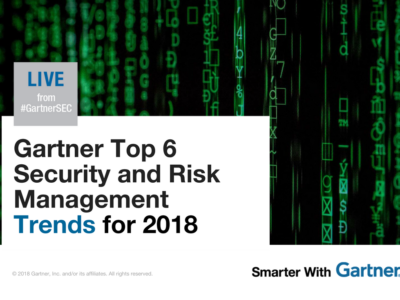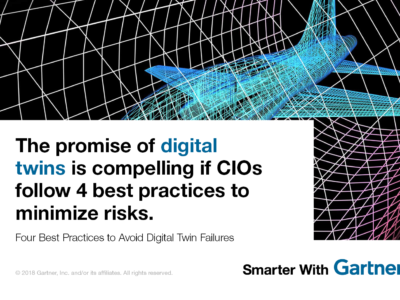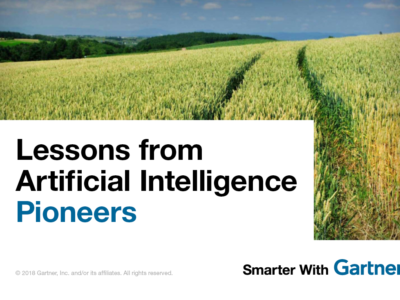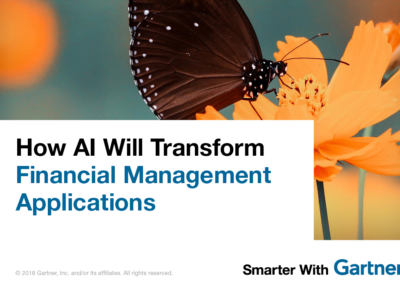Artificial intelligence, machine learning, and smart things promise an intelligent future.
Today, a digital stethoscope has the ability to record and store heartbeat and respiratory sounds. Tomorrow, the stethoscope could function as an “intelligent thing” by collecting a massive amount of such data, relating the data to diagnostic and treatment information, and building an artificial intelligence (AI)-powered doctor assistance app to provide the physician with diagnostic support in real-time. AI and machine learning increasingly will be embedded into everyday things such as appliances, speakers and hospital equipment. This phenomenon is closely aligned with the emergence of conversational systems, the expansion of the IoT into a digital mesh and the trend toward digital twins.
Three themes — intelligent, digital, and mesh — form the basis for the Top 10 strategic technology trends for 2017, announced by David Cearley, vice president and Gartner Fellow, at Gartner Symposium/ITxpo 2016 in Orlando, Florida. These technologies are just beginning to break out of an emerging state and stand to have substantial disruptive potential across industries.
Intelligent
Trend No. 1: AI & Advanced Machine Learning
Applied AI and machine learning (ML), which include technologies such as deep learning, neural networks and natural-language processing, can also encompass more advanced systems that understand, learn, predict, adapt and potentially operate autonomously. Systems can learn and change future behavior, leading to the creation of more intelligent devices and programs.
Examples include eye-gazing technologies in retail stores and sensory data from smartphones that create propensity-to-buy models. Organizations seeking to drive digital innovation with this trend should evaluate a number of business scenarios in which AI and machine learning could drive clear and specific business value and consider experimenting with one or two high-impact scenarios.
Trend No. 2: Intelligent Apps
Intelligent apps, which include technologies like virtual personal assistants (VPAs), have the potential to transform the workplace by making everyday tasks easier (prioritizing emails) and its users more effective (highlighting important content and interactions). Using AI technology, app and service providers will focus on three areas — advanced analytics, AI-powered and increasingly autonomous business processes and AI-powered conversational interfaces. By 2018, Gartner expects most of the world’s largest 200 companies to exploit intelligent apps and utilize the full toolkit of big data and analytics tools to refine their offers and improve customer experience.
Trend No. 3: Intelligent Things
New intelligent things generally fall into three categories: robots, drones and autonomous vehicles. Like intelligent apps, intelligent things could not exist without AI or ML. As intelligent things evolve and become more popular, they will shift from a stand-alone to a collaborative intelligent things model. However, nontechnical issues such as liability and privacy, along with the complexity of creating highly specialized assistants, will slow embedded intelligence in industrial IoT and other business scenarios.
Digital
Trend No. 4: Virtual & Augmented Reality
Virtual reality (VR) and augmented reality (AR) transform the way individuals interact with each other and software systems, deriving visual aspects from the digital mesh. For example, VR can be used for training scenarios. AR, which enables a blending of the real and virtual worlds, means businesses can overlay graphics onto real-world objects, such as hidden wires on the image of a wall.
Trend No. 5: Digital Twin
Within three to five years, billions of things will be represented by digital twins, a dynamic software model of a physical thing or system. Using data provided by sensors, a digital twin understands its state, responds to changes, improves operations and adds value. Digital twins function as proxies for the combination of skilled individuals (e.g., technicians) and traditional monitoring devices and controls (e.g., pressure gauges). Their proliferation will require a cultural change, as those who understand the maintenance of real-world things must collaborate with data scientists and IT professionals who utilize digital twins.
Trend No. 6: Blockchain
Blockchain is a type of distributed ledger in which value exchange transactions (in bitcoin or other token) are sequentially grouped into blocks. The “blockchain” term is hyped to include a loosely combined set of technologies and processes that variously spans middleware, database, security, analytics/AI, monetary and identity management concepts. Blockchain and distributed-ledger concepts are gaining traction because they hold the promise of transforming industry operating models in industries such as music distribution, identify verification and title registry. Bitcoin, however, is the only proven blockchain, and the majority of blockchain initiatives are in alpha or beta phases.
Mesh
Trend No. 7: Conversational Systems
Conversational user interfaces (UIs) can range from simple informal, bidirectional conversations such as an answer to “What time is it” to more complex interactions such as collecting oral testimony from crime witnesses to generate a sketch of a suspect. Conversational systems utilize conversational UI, but not necessarily as the exclusive interface, enabling people and machines to use multiple modalities (e.g., sight, sound, tactile, etc.) to communicate across the digital device mesh (e.g., sensors, appliances, IoT systems).
Trend No. 8: Mesh App and Service Architecture
The intelligent digital mesh will require changes to the architecture, technology and tools used for solutions. The current solution is the mesh app and service architecture (MASA), a multichannel solution architecture that supports multiple users in multiple roles using multiple devices and communicating over multiple networks. However, true digital businesses will need to come up with a more effective solution due to the MASA’s challenges.
Trend No. 9: Digital Technology Platforms
Digital technology platforms are the building blocks for a digital business and are necessary to break into digital. Every organization will have some mix of five digital technology platforms: Information systems, customer experience, analytics and intelligence, the Internet of Things and business ecosystems. Companies should identify how industry platforms will evolve and plan ways to evolve their platforms to meet the challenges of digital business.
Trend No. 10: Adaptive Security Architecture
The evolution of the intelligent digital mesh and digital technology platforms and application architectures means that security has to become fluid and adaptive. Security in the IoT environment is particularly challenging. Security teams need to work with application, solution and enterprise architects to build security into the overall DevOps process to create a DevSecOps model.
Get Smarter
A video replay of this session will be available on Gartner Events on Demand.
Read the complimentary report, Top 10 Strategic Technology Trends for 2017.
Learn how to lead through digital disruption. Download the complimentary CIO Leadership eBook.











